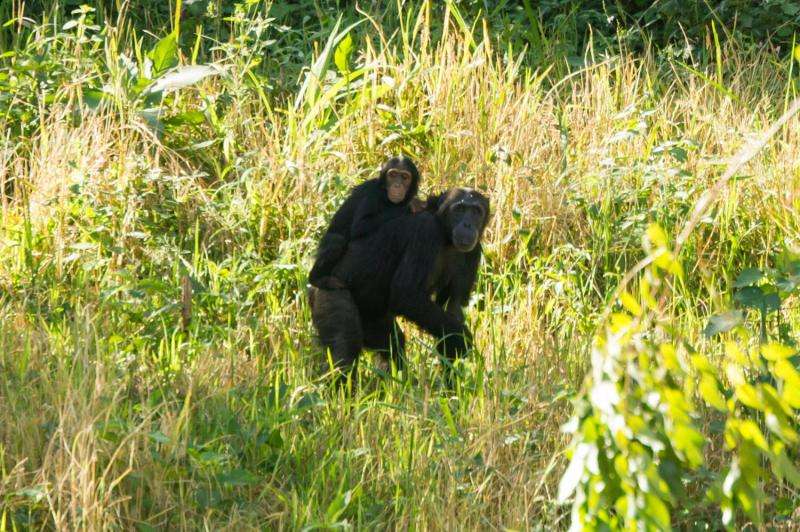A chimpanzee mother and infant cross through farmland Hoima District Uganda. Credit: Jack Lester
A chimpanzee population in Uganda has been found to be three times larger than previously estimated, according to research published in the open access journal BMC Ecology. The study suggests that chimpanzees may adapt to degraded habitats better than expected, but also highlights the importance of new and more focused conservation strategies.
The protected Budongo and Bugoma Forest Reserves together compose approximately one quarter of the estimated total chimpanzee population in Uganda. The unprotected area between these two reserves is a human-dominated landscape comprising forest with villages, agricultural lands and natural grasslands.
At least 450 km2 of forest is estimated to have been lost between the Budongo and Bugoma Forests from 2000 to 2010. As a potential corridor for chimpanzees migrating between two protected areas, these fragmented landscapes could be vital for conservation, but few studies have examined the chimpanzee population of this corridor area.
Counting chimpanzee populations also presents a number of challenges. Direct monitoring is a lengthy process, counting nests can be inaccurate, while the use of camera traps and acoustic monitoring is still in its infancy.
The researchers spent 15 months carrying out 'genetic censusing' to provide an accurate method for counting chimpanzees in the corridor region. This involved collecting 865 chimpanzee fecal samples across 633 km2 and genetically analysing them to identify the presence of 182 different chimpanzees.
They then estimated the total population size of the area to be either 256 or 319 chimpanzees, depending on the calculation used. This suggests the presence of at least nine communities containing a minimum of eight to 33 individuals each. These figures are more than three times greater than a previous estimate of around 70 chimpanzees based on small-scale nest count surveys.
A male chimpanzee looks toward a farm from the forest edge. The tree he sits in was logged some days later. Credit: Jack Lester
Lead author Maureen McCarthy from University of Southern California, USA, said: "Our results demonstrate a much larger population than previously estimated in this region. This is very surprising given the fragmentation of forests in this region and the high human population density. Chimpanzees, therefore, appear surprisingly resilient and can survive even in degraded habitats if they are not hunted. However, their future survival remains uncertain if protection is not afforded to them and habitat loss continues unabated."
The authors say that it is highly improbable that these higher estimates are evidence of population growth since the time of the previous census. This is due to the long interval between chimpanzee births and the high rate of habitat loss throughout the region over the intervening years. The substantially higher estimates instead likely reflect the improved accuracy of the genetic censusing approach over previous estimates.
The surprising levels of chimpanzee survival in a fragmented human-dominated habitat are also likely aided by their behavioral flexibility. This includes incorporating new (often human-cultivated) foods into their diets and adopting more aggressive behaviors to mitigate human threats.
A chimpanzee walks along a logged eucalyptus tree in a clearing in Hoima District Uganda. Credit: Jack Lester
Maureen McCarthy adds: "Our study demonstrates that even unprotected and degraded habitats can have high conservation value. Though national parks and other protected areas are typically prioritized in conservation planning, unprotected areas should also be considered vital for conservation if they are highly valuable as wildlife corridors that harbor endangered species and maintain gene flow among larger populations of such species."
The authors predict that a corridor enhancement project in this region would positively impact 30% of Uganda's total chimpanzee population (including the chimpanzee populations of both Budongo and Bugoma Forests and the region between them).
More information: Genetic censusing identifies an unexpectedly sizeable population of an endangered large mammal in a fragmented forest landscape, Maureen S McCarthy, Jack D Lester, Eric J Howe, Mimi Arandjelovic, Craig B Stanford and Linda Vigilant, BMC Ecology 2015. DOI: 10.1186/s12898-015-0052-x
Journal information: BMC Ecology
Provided by BioMed Central
























